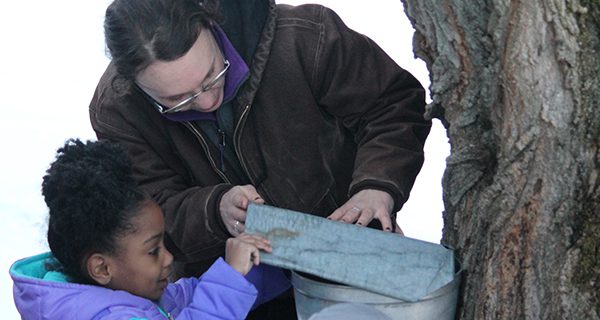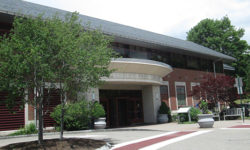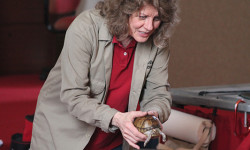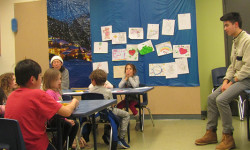[ccfic caption-text format="plaintext"]
By James Kinneen
Hometown Weekly Reporter
While kids looking for snow days, plow drivers looking for easy money, and skiers looking for fresh powder might not be happy February hasn’t been bitterly cold, one group of people are very pleased with the weather: maple syrup makers.
Yes, it ends up that maple sap flows freest when the days are above, but the nights are below freezing. The area’s current weather, needless to say, has been perfect.
This was just one of the fascinating facts about maple syrup making that Farmer Katie and Farmer Katherine from Land’s Sake Farm in Weston brought to the children of the Wellesley Library last Thursday afternoon. But while farmer Katherine’s storytelling and farmer Katie’s enthusiastic syrup trivia was enthralling to the parents, it was clear that the kids just wanted to tap the tree.
That would come in time. First, farmer Katie wanted to make sure the throng of children understood exactly what they were doing. She explained how maple syrup making has been around since before the natives in American and Canada knew what metal was, instead using wooden spiles to tap the sugar maple trees.
Then, she held up the various grades of syrup and explained that the difference in darkness was dependent on how early in the season the syrup was made (the earlier, the lighter).
When Farmer Katie asked the kids what kind of food they eat with maple syrup, the answers were far from diverse.
“Pancakes!” answered the first child.
“Pancakes!” answered the second child.
Finally, farmer Katie asked if anyone knew a food other than pancakes that you eat with maple syrup. “Waffles!” answered a boy sitting up front.
“That’s right!” Katie declared, looking around the crowd before asking “anything else?” A little girl rose from her chair and raised her hand confidently until farmer Katie acknowledged her.
“Pancakes!” she screamed.
Farmer Katie smiled and moved on.
Eventually, farmer Katherine took over, teaching the children how you hug a tree to determine how many buckets of sap it can handle losing, with three being the maximum, no matter how large the tree is. When she was done reading a story about tapping maple trees in the past, Farmer Katie explained that the process was essentially the same, with a bit more modernization.
“We don’t use horses to carry the sap, we use pickup trucks,” she said. “That would be fun, though.”
And just as the kids had gotten restless, the group headed outside the library to tap the tree. After Farmer Katherine explained all the ways one could determine whether the tree is a maple - ranging from the buds that “look like little throwing spears” to the tree’s unique system of opposite branching - she found a spot that had never been tapped before and began drilling.
“The tree needs time to heal” she explained. “If you were getting a bunch of shots, you wouldn’t want them to keep putting the needle in the same hole, right?”
After the assembled kids had drilled using an old hand drill, both children and adults were invited to taste the sap coming out of the tree. It essentially tasted like sugar water and would need to boiled, along with 350 other buckets of sap, to create syrup.
But after you collected all the buckets, boiled all the sap, and packaged the syrup, you’d have so many options of what you could do with it.
Like… pancakes?




























